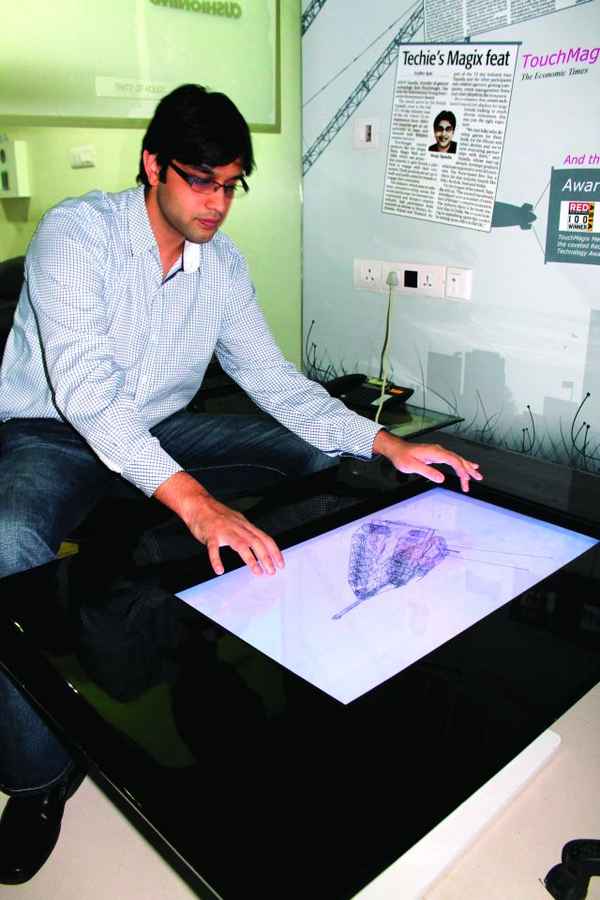Smarter Surfaces is a smarter way to do business
By
Anirudh Regidi |
Updated on 27-Nov-2014
HIGHLIGHTS
It's an interactive world out there. How do you use that to better your enterprise?

We live in a world where we're using gestures everywhere. Where touch-screens were only in the realm of the geek, they're now part and parcel of our lives and aged grandmothers pinch-to-zoom just as easily as toddlers thanks to the plethora of smartphones and tablets that have permeated our lives. So much so in fact that traditional buttons and switches don't seem to cut it anymore.
As a company, you can take advantage of this fact, the gesture-ready human race, and leverage it to your advantage. There are many companies and organizations that provide services that will allow you to create a custom, gesture-based interactive environment for you to best showcase your work and/or draw customers in. In fact, you don’t even need to rely on someone else to do it for you, with a bit of patience, a bit of cash and some intelligent use of yours (or someone else’s) programming skills, you can create your very own gesture-ready display.
How do these “interactive surfaces” work?
Anywhere. Most commercial implementations of this technology involve the use of projectors and Kinect style sensors or infra-red cameras to capture and interpret gestures and other movement. The technology involved is very simple, off-the-shelf components will easily suffice. You essentially have a projector that projects the graphics onto a surface of your choice (a glass surface, a wall or a floor) and a sensor unit that usually comprises of infra-red LEDs and a sensor. The setup will be hooked up to a PC, you don’t need a fancy one, and the requisite software will manage the whole thing for you. As long as you have a surface to project on and the sensor can see that surface, you can create an interactive surface.
The problem is in implementing the system for yourself as there would be quite a bit of image processing (IP) knowledge involved. Companies that provide this service are almost always using the same type of tech to create that surface, though the design may vary slightly, and then leverage their experience in IP and app design to create a solution that suits your needs.
Why bother?
Apart from the fact that interactive surfaces look cool, or rather because of it, they tend to draw attention. You can setup interactive exhibitions for your products, 3D models that people can interact with for example, and various other implementations. It can be something as simple as an entertainment zone for kids in your restaurant or commercial institution of some sort. People will tend to interact with those surface, and inadvertently your product, simply because they’re curious and because it’s a novel experience. Interactive billboards are a huge crowd pleaser as well and implementing them is not as difficult as you might think.
Schools can also use this technology to their advantage as a teaching aid of sorts (http://dgit.in/NS4zWH), not to mention hospitals and other such similar institutions. It need not be that smart surfaces have to be used only for advertising, maybe they’re the best way to showcase your product. The technology is available and it’s only your imagination that is the limiting factor.
Offices can make use of the technology as well, as a digital drawing board if you will. Of course, it can be considered more of an indulgence in such a scenario and it probably is, but hey, it might get more people to enter the conference room and actually contribute.
Now that you’ve got a rudimentary idea as to what goes into the creation of smart surfaces and what you can do with the tech, here’s a roundup of some of the companies that offer such services.
TouchMagix
TouchMagix is a Pune based company that offers various interactive solutions to customers. These include the following:-
• TouchMagix Interactive Wall and Floor: These are essentially the same, it’s just that in once case you have a projector aimed at a wall and in the other, a projector aimed at the floor. The software involved can, of course, differentiate between hands and feet, depending on the orientation.
• TouchMagix Table and Kiosk: These are also the same, almost. One is a table and the other a kiosk but the tech involved is identical. Both use LCD TVs or screens of any sort that are embedded in a frame that uses infra-red beams to detect up to 40 touch points.

Anup Tapadia, founder of TouchMagix demonstrating the TouchMagix table
• TouchMagix Phone: This is an interesting interactive solution that can get people to interact with a display via SMS. It can be something as simple as some sort of voting system at the waiting line at a counter to something that can be used in theatres to say, vote on movies.
• Custom solutions: The Company also provides custom solutions for your interactive surface needs; they’re backed by a team of designers and programmers who can create what you need.
We visited the company’s offices in Pune and got a chance to interact with many of the interactive solutions that they’ve developed and we’ve come back impressed with the fluidity of the interfaces as well as the ease with which the systems can be implemented. For all those who’re curious about their work and what we saw, don’t forget to check out our Alpha DVD this month where we’ve included the videos that we shot there.
The company has a vast portfolio and have worked with many large corporations in India and abroad and include clients such as AT&T, McDonalds, Nokia, Intel, IBM, etc. They can be contacted at http://www.touchmagix.com/
Ubi-Interactive
Ubi-interactive’s solution for the creation of smart surfaces is interesting. They’ve taken Microsoft’s Kinect sensor and essentially implemented the same gestures and responsiveness that you would expect from an Xbox360 with Kinect and allows you to use it on any Windows-based PC. The advantage here is that you can project that screen anywhere and still have fully-functional gestures.
At $1500 for a 20 touch point implementation, setting up a system is expensive, but cheaper than many other enterprise level solutions that we’ve seen. Also, the fact that there is no custom hardware involved means that getting spare parts is easy. Full details are available at: http://www.ubi-interactive.com/
DIY Solutions
Setting up a smart surface need not be a ridiculously expensive project, especially if it’s just for setting up a small, elegant solution for a restricted audience. There are plenty of tools and resources online that can get you started.
Atlas Gloves
This is a very simple DIY solution that anyone with a PC and `50 to spare can implement. Just head to http://atlasgloves.org and go through the site. They’ve provided the source code as well as instructions to build your own gloves from scratch.
The project might seem very basic on the surface and you’re only restricted to one app (Google Earth) as a demo, but, with some rudimentary programming skills and some degree of determination, you can take the basic concept and source code to create almost any kind of responsive display that you like.
Intel
Intel has provided the so-called “Creative Interactive Gesture Camera Development Kit.” The kit consists of a 3D camera (a slightly more complex webcam with two lenses instead of one) and support via the Intel SDK to get any developer started on the development. The camera and software can recognize simple gestures out of the box. You can purchase the kit for yourself at http://dgit.in/152jJy4
 Survey
Survey✅ Thank you for completing the survey!